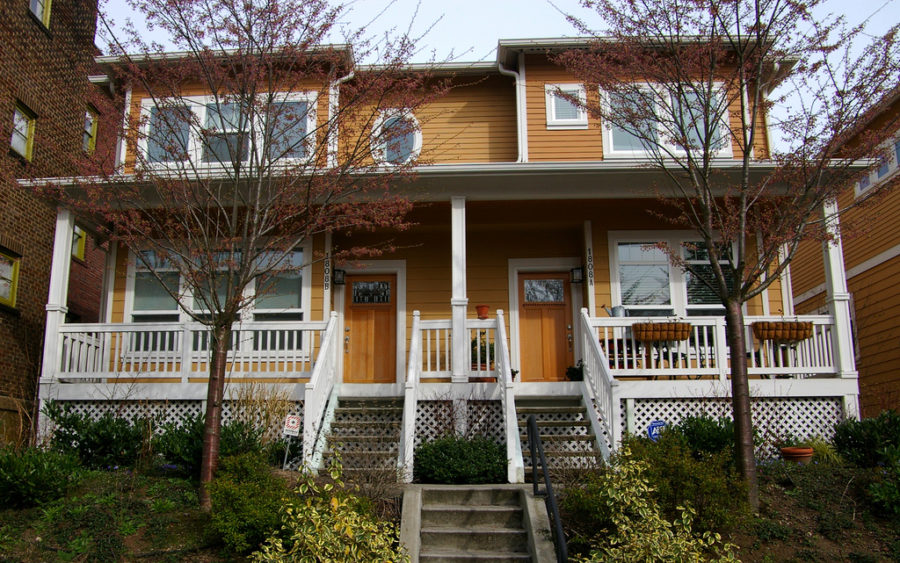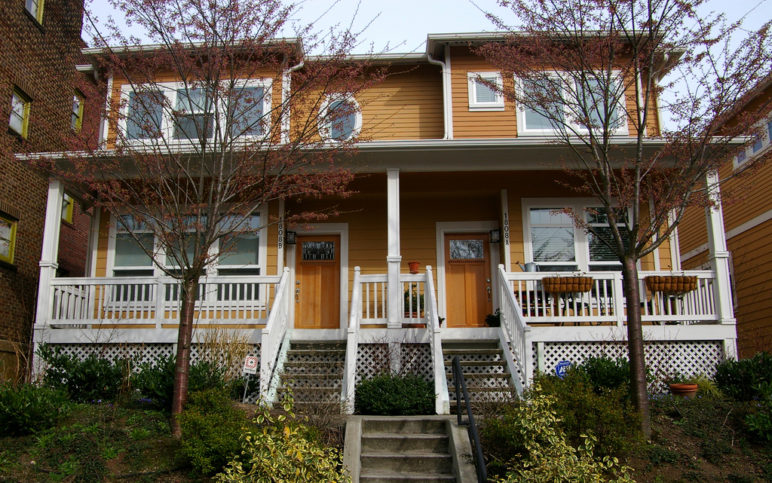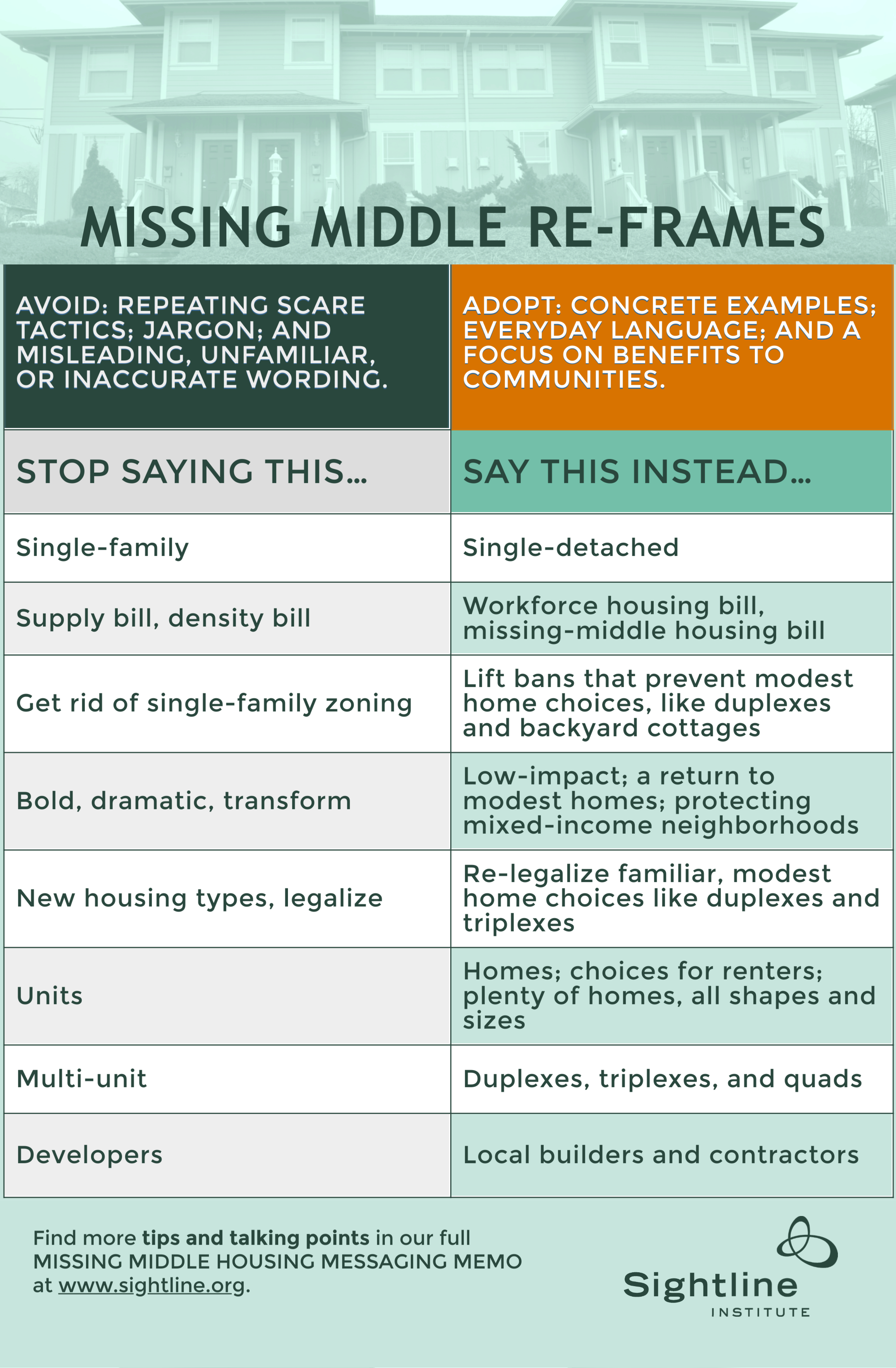Since June, when wide, bipartisan majorities of Oregon’s legislature re-legalized duplexes, triplexes and fourplexes statewide, Sightline’s housing affordability and green urbanism team has fielded one question over and over: How did this happen?
It took years of careful work by a robust coalition, including one of the most powerful politicians in the state. Backers ranged from Habitat for Humanity to AARP of Oregon to Lane County NAACP to Sunrise PDX to Portland Public Schools, all powerful voices who made the case that middle housing makes it easier to age in place, starts to undo some of the ways racism has undermined housing affordability for all, is an essential way to fight climate change, and helps reduce school segregation. (Last month, The Century Foundation published Richard Kahlenberg’s useful overview of political strategy behind zoning reforms in Minneapolis and Oregon.)
But an aspect that the two of us worked on may also be useful to people seeking to replicate state-level affordability solutions: How to talk about missing-middle homes.
Just after the bill was introduced in January, Sightline circulated this memo to fellow supporters. It’s based on our own message testing and on best practices we’ve gathered together from leaders in Oregon and across the country. It includes words and phrases to use and avoid, and pivots from common opposition arguments.
Some top-level takeaways were previously shared, but Sightline is making the full memo available. Check out a downloadable version here.
Emphasize what’s to gain, not what fearmongers will claim is lost
One of the most important things reformers in Oregon did: Avoided talking about single-detached zoning (the upzoning boogeyman entrenched opponents flaunted). Instead, the emphasis was on the things this bill legalized. (Or, if you want to be historically precise about it, re-legalized.)
Almost no one thinks “single-family zoning” is outrageous, despite all the ways it harms us: It limits housing choices, elevates prices, segregates cities.
But when you tell people that duplexes are illegal to build in most of the United States and Canada, most people do actually find that outrageous. You’re saying the same thing, but the emphasis is on what we stand to gain.
Reformers in Minneapolis, California and Seattle also focused on gains. Despite the national headlines after the Minneapolis council voted 12-1 to “eliminate single-family zoning,” advocates had spent a year talking about legalizing fourplexes. (Anti-housing activists chipped that proposal down to three units near the end of the process.)
In California and Seattle, the story was similar: The focus was on legalizing up to two secondary cottages per lot, not on doing away with single-detached zoning.
State legislatures are good places to pursue these reforms
Missing-middle homes are a key ingredient of affordable cities, and statewide action makes sense as a way to get them re-legalized. After all, a region’s roads, transit systems, and housing and job markets knit lives together across many cities and towns. Affordability problems know no municipal borders. To bring prices under control, and curb pollution and inequity resulting from long, costly commutes, cities need to band together—and leaders and advocates need consistent, strategic messages about the benefits of missing middle solutions.
Sightline’s team is always learning more about how to do this most effectively. We hope the things we’ve learned will be useful to you, too.
Here are re-frames and language dos and don’ts. Find the full memo, including more tips and talking points here.












J DUncan
Love it and super helpful. Thanks!
Dan Hayes
Awesome re-framing of an important conversation!
Chris Dickinse
Modest homes are so important. While this brings in much needed housing stock it usually doesn’t increase home ownship. Cottages are built on the homeowners property and rented out by that homeowner thereby adding to their wealth. Developers tear down smaller affordable homes to build duplexes that grow their portfolios. 1st time home owners are still without opportunity and those that “have” continue to widen the gap. Not a reason to stop middle housing. It just doesn’t provide the stability of middle housing if the past did along with the ability to pass on that gain to future generations
Michael Andersen
I totally agree that we need to address the wealth gap in general and the wealth gap in particular, and that re-legalizing smaller, attached homes doesn’t in itself do either. But I don’t think they make it worse — and the way to address the wealth gap is to redistribute money, not to prevent money from doing useful things. That just fosters a different sort of wealth hoarding. Cottages, for example, aren’t more profitable to build and rent than putting $200,000 in an index fund, at least these days, and unlike most stock investments, they create homes that people (low-wealth renters, even) can choose to live in. That’s all to the good IMO, so I don’t see that as a problem with ADUs.
It’s totally true that home prices in relatively prosperous cities have made it impossible to build small buildings without losing money — even if you only wanted a tiny house, to get your hands on a 5,000 square foot lot you have to bid against somebody who wants to build the mansion you don’t want. But this isn’t actually a barrier to small homes. In higher-priced cities, the secret to getting small homes is to make it legal for several small homes to team up.
Richard Cheverton, homeowner
This is why this citizen winds up deeply distrusting our local progressives. Not only do they know–just KNOW–what is best for the entire state of Oregon, they now have developed an Orwellian truthspeak to promote it.
The “Missing Middle” progressive/development alliance has not yet begun actually tearing down/building up–little early to proclaim it a success, unless one talks in terms of ramming legislation through Oregon’s essentially one-party (and one faction of one party) legislature. The tear-downs and fourplexes have yet to appear. A different vocabulary won’t change the coming reality: a creeping swap of equity-building ownership for rental tenements. Oh happy day! Enjoy the revolution, while you can.
Michael Andersen
I think Orwell’s 1984 language nightmare was pretty different, Richard: Oceania was using newspeak to obscure the possibility of change and keep policy discussion out of ordinary people’s mouths.
Personally I think of this work, trying to come up with words that help people discuss policy choices in plainer language, as more related to the practices Orwell was arguing for (in his own voice) in Politics and the English Language:
Of course we have a perspective here about how to build a fair, prosperous and sustainable region, and we’re trying to help our friends win arguments. But part of our aspiration with posts like this is to help us all move back toward concreteness when talking about housing policy, whatever our positions are.
As a side note, I have some strong suspicions about where Orwell’s sympathies would lie in the revolution you’ve imagined. 🙂
Michael Andersen, tenant
Richard Cheverton
Michael…Re: “…the revolution you’ve imagined…” I do not imagine a revolution; actually I imagine the reverse: some feeling of sympathy for what actually exists. Which is that fragile entity known as “a neighborhood.” Which seems, in your lexicon–and thinking–as simply something that exists to be tinkered with, in pursuit of something that is “fair, prosperous and sustainable.” Which are rather slippery terms, wouldn’t you agree? Let’s start with “fair.” Fair…to who? Definitely not to home-owners, who made the biggest investment of their lives with one eye on the old real estate dictum: Location-location-location. Is it “fair” to plump down a 4-plex in the middle of what had been a stable, equity-building neighborhood. Well, we shall see, won’t we–courtesy of Speaker Kotek and her party.
One could go on–“prosperous”? Well, yes! For the builders. And “sustainable”–oh, beloved progressive word! Again–who is being “sustained”? The present owners? That’s a heavy lift–which is why you and yours have to slip-slide the language.
Brad
Keep in mind Sightline is an advocacy group, not a neutral news source. They are suggesting language that makes their side seem more virtuous.
The suggestion to replace “developers” with “local builders”… ha, now there’s a lie.
Michael Andersen
We’re a sustainability think tank. We form opinions based on the facts as we read them and then share our opinions, supported by those facts, with a goal of advancing our vision of a just and sustainable region. You’re right: part of politics is using language that helps people see things the way we do. You don’t have to use our language if you see things differently—we can still arrive at a conversation about facts even if we’re using different words.
On “local builders,” Anna may be able to say more on that but at least in Portland I’m not aware of anyone who hires builders from outside the region except presumably for a few super specialized tasks.
Daniel Jansenson
“In California and Seattle, the story was similar: The focus was on legalizing up to two secondary cottages per lot, not on doing away with single-detached zoning. ”
For California that is incorrect. SB50 (or its precursors) actually mandated an end to single-family detached zoning altogether. But it raised such opposition that it was transformed into legislation allowing up to 2 ADUs per property, and doing away with the owner-residency requirement.
Michael Andersen
This isn’t quite right, Daniel – the ADU reforms attracted a lot of the same fans, but were on a separate track and were working through the system before the very different TOD-focused SB 50 stalled.